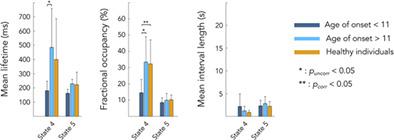当前位置:
X-MOL 学术
›
Hum. Brain Mapp.
›
论文详情
Our official English website, www.x-mol.net, welcomes your feedback! (Note: you will need to create a separate account there.)
Age of onset modulates resting-state brain network dynamics in Friedreich Ataxia
Human Brain Mapping ( IF 4.8 ) Pub Date : 2021-09-15 , DOI: 10.1002/hbm.25621 Gilles Naeije 1, 2 , Nicolas Coquelet 1 , Vincent Wens 1 , Serge Goldman 1, 3 , Massimo Pandolfo 4 , Xavier De Tiège 1, 3
Human Brain Mapping ( IF 4.8 ) Pub Date : 2021-09-15 , DOI: 10.1002/hbm.25621 Gilles Naeije 1, 2 , Nicolas Coquelet 1 , Vincent Wens 1 , Serge Goldman 1, 3 , Massimo Pandolfo 4 , Xavier De Tiège 1, 3
Affiliation

|
This magnetoencephalography (MEG) study addresses (i) how Friedreich ataxia (FRDA) affects the sub-second dynamics of resting-state brain networks, (ii) the main determinants of their dynamic alterations, and (iii) how these alterations are linked with FRDA-related changes in resting-state functional brain connectivity (rsFC) over long timescales. For that purpose, 5 min of resting-state MEG activity were recorded in 16 FRDA patients (mean age: 27 years, range: 12–51 years; 10 females) and matched healthy subjects. Transient brain network dynamics was assessed using hidden Markov modeling (HMM). Post hoc median-split, nonparametric permutations and Spearman rank correlations were used for statistics. In FRDA patients, a positive correlation was found between the age of symptoms onset (ASO) and the temporal dynamics of two HMM states involving the posterior default mode network (DMN) and the temporo-parietal junctions (TPJ). FRDA patients with an ASO <11 years presented altered temporal dynamics of those two HMM states compared with FRDA patients with an ASO > 11 years or healthy subjects. The temporal dynamics of the DMN state also correlated with minute-long DMN rsFC. This study demonstrates that ASO is the main determinant of alterations in the sub-second dynamics of posterior associative neocortices in FRDA patients and substantiates a direct link between sub-second network activity and functional brain integration over long timescales.
中文翻译:

发病年龄调节弗里德赖希共济失调的静息状态脑网络动力学
这项脑磁图 (MEG) 研究解决了 (i) Friedreich 共济失调 (FRDA) 如何影响静息状态大脑网络的亚秒级动力学,(ii) 其动态改变的主要决定因素,以及 (iii) 这些改变如何与FRDA 相关的静息状态大脑功能连接 (rsFC) 变化在很长一段时间内。为此,在 16 名 FRDA 患者(平均年龄:27 岁,范围:12-51 岁;10 名女性)和匹配的健康受试者中记录了 5 分钟的静息状态 MEG 活动。使用隐马尔可夫模型 (HMM) 评估瞬态大脑网络动态。事后中位数分割、非参数排列和斯皮尔曼等级相关用于统计。在 FRDA 患者中,在症状发作年龄 (ASO) 与涉及后默认模式网络 (DMN) 和颞顶叶连接 (TPJ) 的两个 HMM 状态的时间动态之间发现了正相关。与 ASO > 11 岁的 FRDA 患者或健康受试者相比,ASO <11 岁的 FRDA 患者的这两种 HMM 状态的时间动态发生了改变。DMN 状态的时间动态也与一分钟长的 DMN rsFC 相关。这项研究表明,ASO 是 FRDA 患者后联想新皮层亚秒动力学改变的主要决定因素,并证实了亚秒网络活动与长期功能性大脑整合之间的直接联系。与 ASO > 11 岁的 FRDA 患者或健康受试者相比,11 岁时这两种 HMM 状态的时间动态发生了变化。DMN 状态的时间动态也与一分钟长的 DMN rsFC 相关。这项研究表明,ASO 是 FRDA 患者后联想新皮层亚秒动力学改变的主要决定因素,并证实了亚秒网络活动与长期功能性大脑整合之间的直接联系。与 ASO > 11 岁的 FRDA 患者或健康受试者相比,11 岁时这两种 HMM 状态的时间动态发生了变化。DMN 状态的时间动态也与一分钟长的 DMN rsFC 相关。这项研究表明,ASO 是 FRDA 患者后联想新皮层亚秒动力学改变的主要决定因素,并证实了亚秒网络活动与长期功能性大脑整合之间的直接联系。
更新日期:2021-10-17
中文翻译:

发病年龄调节弗里德赖希共济失调的静息状态脑网络动力学
这项脑磁图 (MEG) 研究解决了 (i) Friedreich 共济失调 (FRDA) 如何影响静息状态大脑网络的亚秒级动力学,(ii) 其动态改变的主要决定因素,以及 (iii) 这些改变如何与FRDA 相关的静息状态大脑功能连接 (rsFC) 变化在很长一段时间内。为此,在 16 名 FRDA 患者(平均年龄:27 岁,范围:12-51 岁;10 名女性)和匹配的健康受试者中记录了 5 分钟的静息状态 MEG 活动。使用隐马尔可夫模型 (HMM) 评估瞬态大脑网络动态。事后中位数分割、非参数排列和斯皮尔曼等级相关用于统计。在 FRDA 患者中,在症状发作年龄 (ASO) 与涉及后默认模式网络 (DMN) 和颞顶叶连接 (TPJ) 的两个 HMM 状态的时间动态之间发现了正相关。与 ASO > 11 岁的 FRDA 患者或健康受试者相比,ASO <11 岁的 FRDA 患者的这两种 HMM 状态的时间动态发生了改变。DMN 状态的时间动态也与一分钟长的 DMN rsFC 相关。这项研究表明,ASO 是 FRDA 患者后联想新皮层亚秒动力学改变的主要决定因素,并证实了亚秒网络活动与长期功能性大脑整合之间的直接联系。与 ASO > 11 岁的 FRDA 患者或健康受试者相比,11 岁时这两种 HMM 状态的时间动态发生了变化。DMN 状态的时间动态也与一分钟长的 DMN rsFC 相关。这项研究表明,ASO 是 FRDA 患者后联想新皮层亚秒动力学改变的主要决定因素,并证实了亚秒网络活动与长期功能性大脑整合之间的直接联系。与 ASO > 11 岁的 FRDA 患者或健康受试者相比,11 岁时这两种 HMM 状态的时间动态发生了变化。DMN 状态的时间动态也与一分钟长的 DMN rsFC 相关。这项研究表明,ASO 是 FRDA 患者后联想新皮层亚秒动力学改变的主要决定因素,并证实了亚秒网络活动与长期功能性大脑整合之间的直接联系。


























 京公网安备 11010802027423号
京公网安备 11010802027423号